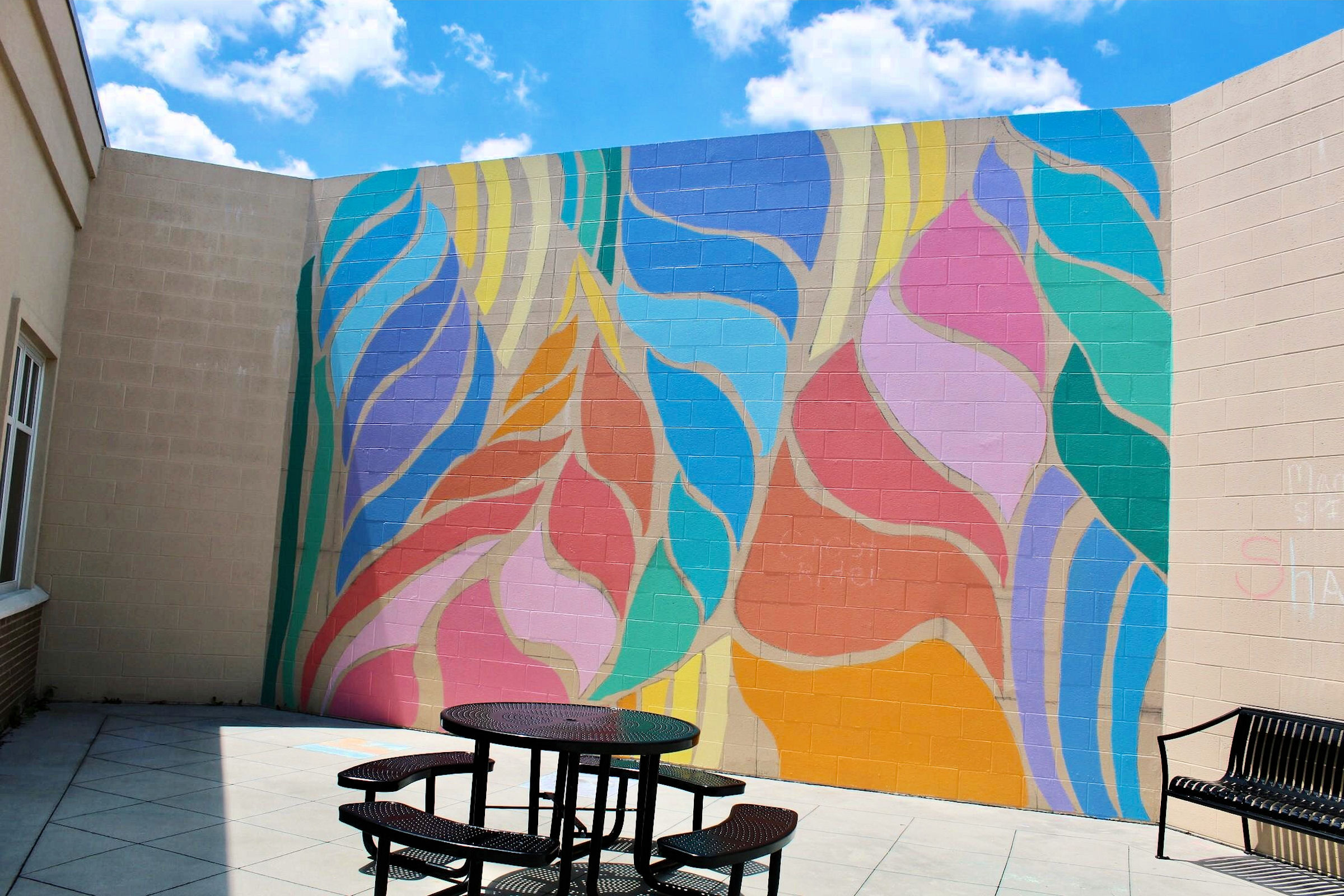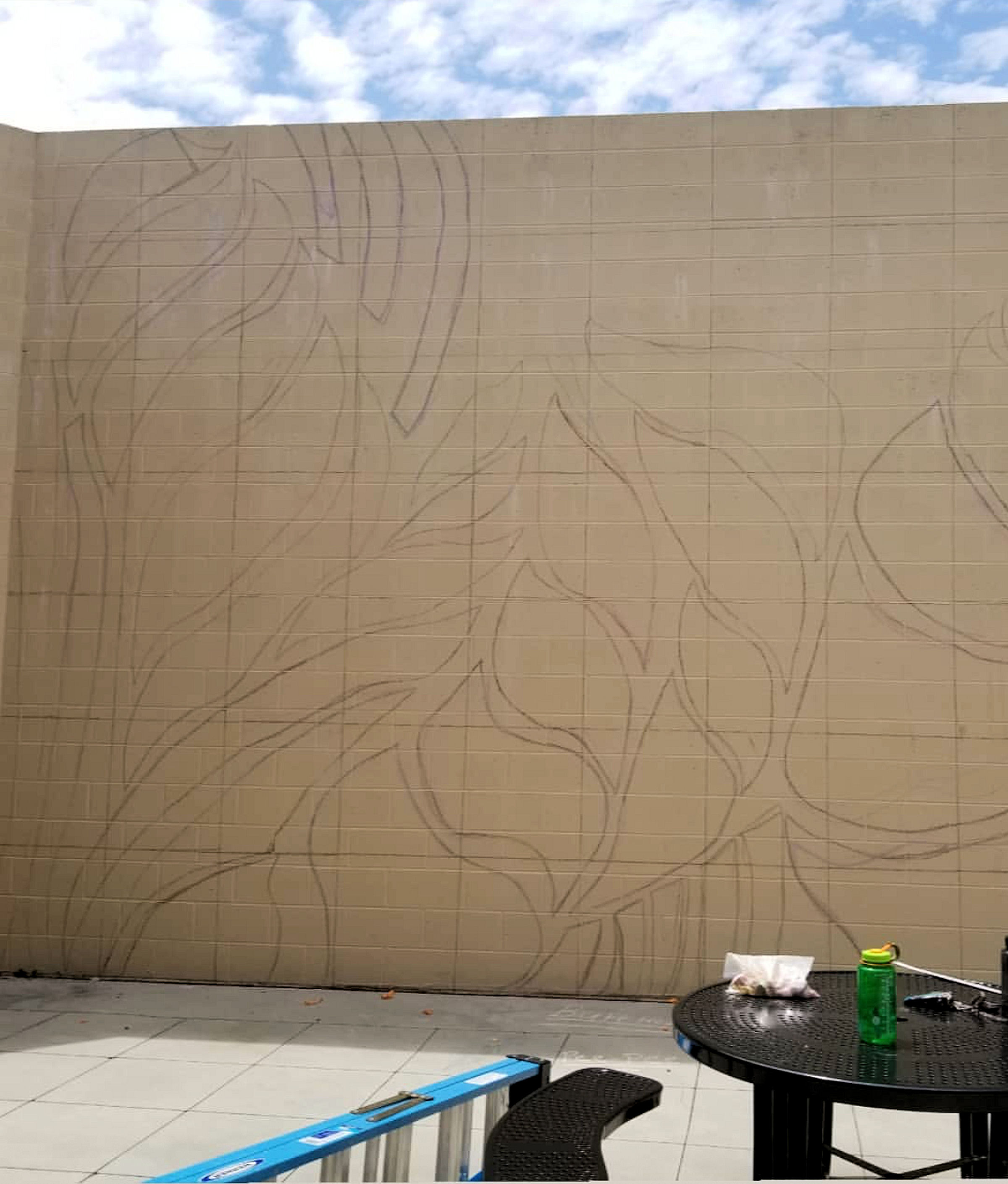Healing artwork has transformed a courtyard in Willowbrooke at Tanner — thanks to some talented volunteers.
Morgan Dykes, 18, and Sydney Roe, 18, painted a 15-by-23-foot mural in the courtyard of Unit 4 at Willowbrooke at Tanner, the inpatient behavioral health facility in Villa Rica. Both are Douglasville natives who study at Mercer University.
Willowbrooke at Tanner provides a continuum of mental health care and access to clinically proven treatments for people of all ages through inpatient and outpatient services.
Its 92-bed inpatient facility offers short-term, acute behavioral health care for children, adolescents and adults. Willowbrooke at Tanner helps people with a wide range of issues — from depression and anxiety to anger management and substance abuse.
The mural wasn’t the first time that Dykes and Roe have worked together as artists volunteering in their community. As the former co-presidents of Douglas County High School’s art club, they volunteered to paint murals and theater sets for middle and high schools. At the Villa Rica Arts Festival, they volunteered face painting at a booth Tanner sponsored to raise awareness about mental health.
But the
Willowbrooke at Tanner mural was a unique project for the young artists.

“We hadn’t done anything of this magnitude or something so permanent, so this was really exciting for us,” Dykes said. “It was a very meaningful project.”
Dykes, who wants to be a psychiatrist, is in a pre-med track at Mercer University majoring in biology and Spanish. Roe, who plans to be a speech language pathologist, is majoring in education and Spanish.
They got assistance from Joseph Albrightson, a Douglasville native who also studies at Mercer University. His height was a big advantage for hard-to-reach places on the mural, said Dykes, adding that they needed several different sizes of ladders to reach the top.
The young artists met with Willowbrooke at Tanner administrators to learn about how the mural needed to be done.
Understanding Traumatic Experiences
The mural reflects Willowbrooke at Tanner’s commitment to trauma-informed care.
Trauma-informed care is a way of approaching patient care with an understanding that many patients have been through some form of trauma.
For example, 1 in 3 women and 1 in 4 men experience sexual violence during their lifetimes, according to the Centers for Disease Control and Prevention (CDC). Nearly 1 in 5 adult women and 1 in 7 adult men report having experienced severe physical violence from an intimate partner in their lifetime, according to the CDC. At least 1 in 7 children have experienced child abuse and/or neglect in the past year, says the CDC, adding that this is likely an underestimate.
This means that many Americans have experienced some form of significant trauma.
Victims of trauma may suffer from post-traumatic stress disorder and are at increased risk for some behavioral health problems.
“Going to a hospital is hard for someone who has suffered trauma,” said Wayne Senfeld, Ed.S., LPC, senior vice president of behavioral health at Tanner. “Some people experience flashbacks or anxiety, so they avoid medical appointments altogether. It’s important to create a safe, healing environment for them.”
Trauma-informed care is defined as practices that promote a culture of safety, empowerment and healing, according to Harvard Health Publishing of Harvard Medical School.
Trauma-informed care fits with Willowbrooke at Tanner’s mission to provide the highest quality behavioral health care in a professional, responsive and caring manner, said Senfeld.
“Making this a safe, welcoming place is essential for a therapeutic environment,” said Senfeld. “People come here to get well — not to suffer more trauma.”
A Meaningful Mural
The mural embraces trauma-informed care by avoiding anything that could be potentially triggering for trauma victims and by highlighting positive and healing elements in its design.
For example, Willowbrooke at Tanner administrators asked the artists to avoid any sharp edges or colors that could potentially trigger traumatic memories.
“We had to be very conscious of the physical shapes we used and stay away from any sharp points because that can remind people of trauma that they went through,” Dykes said. “We needed to avoid colors like red, dark purple and black because those could trigger a traumatic memory of blood and bruises.”

The mural design features cheerful colors and smooth, rounded shapes.
“We wanted to transform the brick wall and give them something brighter and more interesting to look at,” said Dykes.
The mural was also designed to be calming and peaceful.
“You can imagine that people are probably a little scared and overwhelmed when they are seeking help for a behavioral health problem,” said Roe. “The mural is a small — but meaningful — way to create some calm in their experience.”
The mural, which was created in summer 2019, began with a grid design drawn in grease pencil to make sure that the art wouldn’t get washed away by rain as the artists worked it.
Dykes and Roe used a simple design so that the mural can be touched up as needed over the years by people who are not artists.
The mural project also helped bring the mental health conversation to social media, Roe said.
“We posted almost every day about our progress on the mural and how important it is to raise awareness about mental health,” said Roe. “There is still a big stigma around mental health, but there shouldn’t be.”
Making Room for Art
The young artists hope their work will be a positive presence at Willowbrooke at Tanner.
“Art is a good way for people to think about things and express how they are feeling without having to do it verbally,” said Dykes. “Art can be a good way to think, feel and communicate without having the pressure of having to put everything into words.”
Art has another important role at Willowbrooke at Tanner. As part of its outpatient care programs, Willowbrooke at Tanner offers expressive therapy for patients of all ages.
Expressive therapy uses the creative process of art for healing. Therapists use drawing, painting and other art forms to assess and treat clients with emotional, cognitive, physical and/or developmental disorders.
The creative process helps patients gain new insights, cope better with stress, work through traumatic experiences and improve relationships.
Willowbrooke at Tanner offers other innovative approaches to behavioral health, such as animal-assisted therapy, rhythmic therapy and an equine therapy summer program.
“It’s essential to meet patients where they are and find the right therapeutic approach or combination of therapies that is going to work best for each individual,” said Senfeld. “We’re grateful that these artists were willing to work with us to make something meaningful for our patients. Through art, a lot of people find healing.”